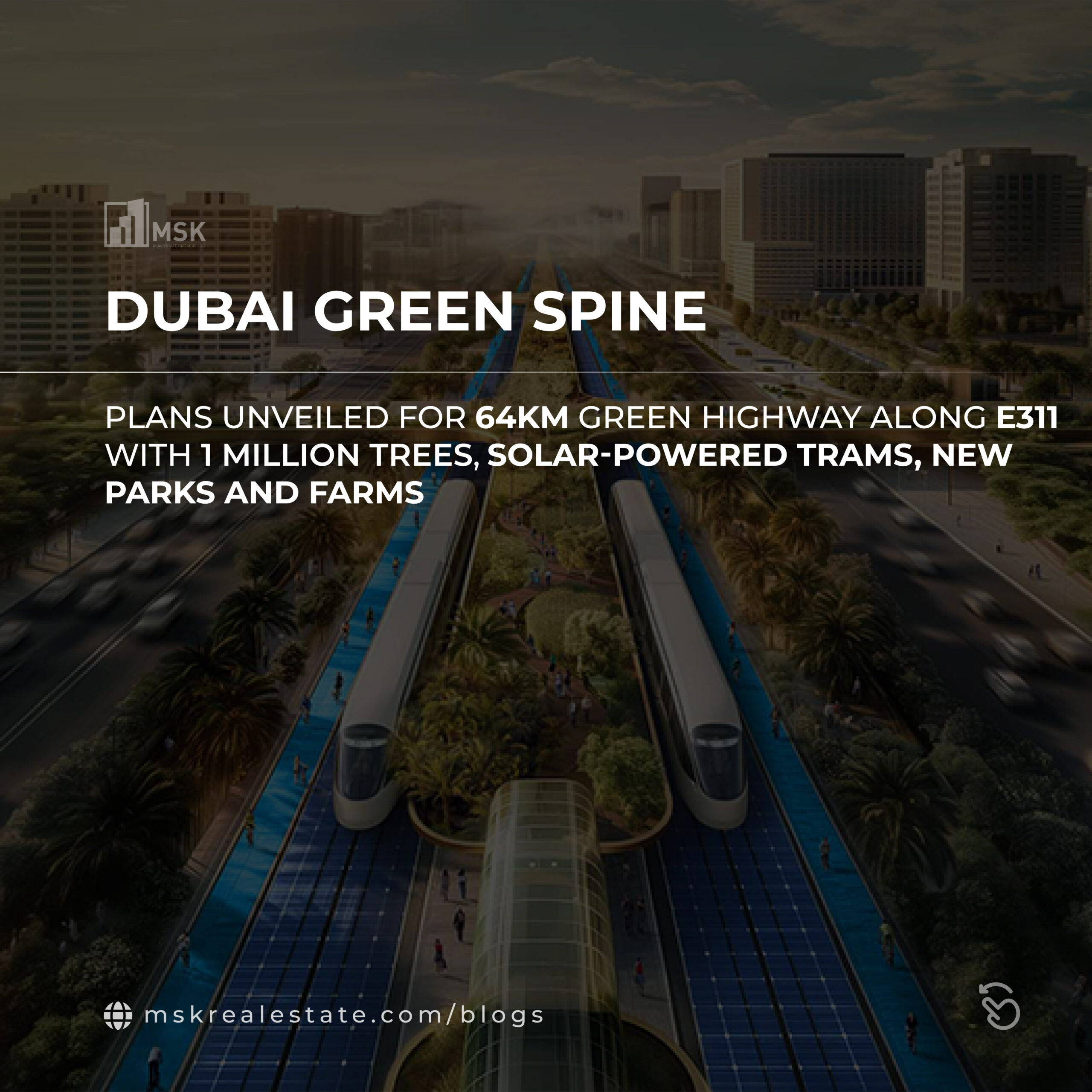
The Dubai Green Spine is a transformative urban development initiative that is set to redefine the Sheikh Mohammad Bin Zayed Road (E311) into a 64-kilometer-long sustainable corridor. This ambitious project exemplifies Dubai’s commitment to innovative, sustainable, and integrated urban planning. It aligns with the visionary Dubai 2040 Urban Master Plan, which anticipates the city’s growth to nearly 8 million residents. The Green Spine aims to enhance urban mobility, improve environmental quality, and create a vibrant, sustainable community space that serves as a model for future global urban development.
A Vision for the Future
Set against the backdrop of Dubai’s rapid expansion and its evolving needs, the Green Spine is more than just an infrastructure project; it is a strategic endeavor to cultivate a greener, more livable city. By converting one of the city’s major arterial roads into a multifunctional public realm, the project introduces extensive greenery, promotes non-motorized transport, and integrates renewable energy sources. These features are designed to significantly reduce the city’s carbon footprint, improve air quality, reduce urban heat, and offer residents and visitors accessible, safe, and attractive routes for commuting and leisure, thereby enhancing the overall quality of urban life.
Designed by Visionaries
The Dubai Green Spine project is designed by URB, the same masterminds behind pioneering projects such as the Dubai Reefs Project, Dubai Mangroves, and The Loop in Dubai. URB’s CEO, Baharash Bagherian, describes the project as a paradigm shift: “The Dubai Green Spine isn’t just about transit; it’s about transforming urban functionality, making the city more livable and human-centric. It challenges conventional infrastructure norms, proving that our streets can do more than facilitate car traffic; they can significantly enhance quality of life.”
Bagherian emphasizes the human-centric approach of the project, which prioritizes people and green spaces over cars. “The Dubai Green Spine is at the forefront of this shift, transforming urban spaces into vibrant, healthy environments that serve as the city’s lungs and arteries. This initiative promotes sustainable modes of transport and community zones over traditional car-dominated roads, thus enhancing the quality of urban life. We’re not just improving mobility; we’re creating an environment where people thrive. This forward-thinking approach is the future of urban planning, focusing on the well-being and connectivity of all residents.”
Integrating Technology and Sustainability
The Green Spine also incorporates cutting-edge technology and smart urban planning principles. It will feature IoT-enabled infrastructure, real-time traffic management systems, and energy-efficient buildings, setting a benchmark in smart city solutions. This integrated approach ensures that the corridor not only supports the current population but is also adaptable to future technological advancements and environmental challenges.
Economic, Social, and Environmental Benefits
This project is a critical component of Dubai’s broader goals to foster economic growth, social cohesion, and environmental sustainability. By creating a continuous linear park along with commercial and cultural hubs, the Green Spine facilitates economic opportunities and community interactions, knitting together diverse neighborhoods into a cohesive urban fabric. Educational, recreational, and cultural programs along the Spine will engage communities, making the space a dynamic center for social exchange and cultural enrichment.
Through its comprehensive design that blends functionality with aesthetics, the Dubai Green Spine aims to transform the urban landscape, making Dubai a global leader in urban sustainability. This project is not just a pathway for transit; it’s a lifeline for the city’s future, ensuring that Dubai remains at the forefront of innovative urban solutions, and setting a precedent for cities around the world aiming to combine growth with sustainability.
Key Facts
- 64km sustainable urban corridor.
- 300 megawatts of solar power.
- Promotes biodiversity with 1 million trees.
- Aligns with Dubai 2040 Plan.
- Promotes non-motorized transport.
- Significantly reduces carbon footprint.
- Enhances community connectivity.
- Incorporates urban farms and gardens.
- Utilizes porous drainage systems.
- Fosters economic and social growth.
Strategic Importance and Vision
The Dubai Green Spine, strategically situated along Sheikh Mohammad Bin Zayed Road (E311), is designed to fundamentally transform one of Dubai’s major transportation arteries into a vibrant, multifunctional urban corridor. This initiative is directly aligned with the Dubai 2040 Urban Master Plan, which anticipates a significant population increase, necessitating robust infrastructure that can support both current and future mobility and sustainability demands.
The Green Spine is pivotal for enhancing urban connectivity and efficiency across Dubai, facilitating smoother and faster commutes between various residential, commercial, and cultural districts. This enhanced connectivity is expected to drive substantial economic growth, attract investments, and improve the overall urban fabric of the city. By integrating a mix of community amenities, commercial and recreational spaces with green infrastructure and sustainable transport options, the project aims to reduce the city’s dependence on automobiles, thereby decreasing traffic congestion and lowering carbon emissions.
Addressing Environmental Challenges
Moreover, the Green Spine addresses critical environmental challenges by incorporating extensive green spaces that are expected to improve air quality and reduce the urban heat island effect. These green spaces will be integrated with pedestrian paths, cycling tracks, and electric tram lines, creating a seamless and environmentally friendly transportation network. This approach not only enhances the aesthetic appeal of the corridor but also promotes a healthier, more sustainable lifestyle among Dubai’s residents.
This project also plays a crucial role in future-proofing the city against environmental, economic, and social shifts. By fostering a resilient infrastructure that can adapt to changing climate conditions and urban demands, the Green Spine ensures long-term sustainability. It is designed to be a dynamic model for urban development, showcasing how integrated planning and innovative design can create a thriving, sustainable city that attracts global attention and sets new standards for urban living.
Economic, Social, and Environmental Sustainability
The Dubai Green Spine is poised to become a catalyst for sustainable urban development, intertwining economic, social, and environmental benefits into a cohesive and innovative project. Economically, this initiative is expected to bolster Dubai’s economy by creating a multitude of job opportunities and stimulating growth in sectors such as construction, technology, and services. The integration of commercial spaces along the corridor will attract businesses and entrepreneurs, thereby increasing property values and enhancing the economic vitality of the area.
Socially, the Green Spine is designed to significantly improve the quality of life for residents and visitors by offering safe, accessible, and vibrant public spaces. These areas are tailored to encourage a range of activities that foster social interactions and community bonding. From playgrounds and sports facilities to cultural venues and open green spaces, the Green Spine will facilitate community engagement and active lifestyles, promoting social well-being across diverse population groups. Furthermore, the project aims to improve mobility by providing efficient and eco-friendly transportation options, reducing commute times, and making the city more navigable.
From an environmental standpoint, the Green Spine sets a new standard for sustainability. The project emphasizes the use of renewable energy sources, particularly solar power, to run public transportation systems and light public areas. Advanced water management systems are planned to optimize water use and enhance water conservation, crucial in Dubai’s arid climate. Additionally, the extensive planting of trees and vegetation along the corridor will not only beautify the area but also play a critical role in air purification and the reduction of urban heat, contributing to a healthier and more sustainable urban environment.
Renewable Energy Innovations
The Dubai Green Spine is set to be a hallmark of sustainability, with a strong emphasis on renewable energy that aligns with Dubai’s clean energy initiatives. This ambitious project plans to utilize 100% renewable energy sources to power its infrastructure, primarily focusing on solar energy—a plentiful resource in Dubai’s arid climate. This commitment reflects a significant shift towards reducing the city’s carbon footprint and promoting environmental stewardship at a municipal scale.
Solar panels will be extensively integrated into the architecture of the Green Spine. The tram system, a central feature of the Green Spine, will be especially notable for its use of ground-breaking technology that incorporates solar panels directly into the tram tracks. This not only provides a constant source of power to the tram network but also reduces the need for extensive overhead power lines, maintaining the aesthetic integrity of the corridor.
In total, the Dubai Green Spine project can generate over 300 megawatts of clean, renewable energy. This impressive output is sufficient to power approximately 130,000 homes in Dubai, demonstrating the project’s substantial contribution to the city’s energy needs. Moreover, by using solar power instead of fossil fuels, the project helps reduce CO2 emissions by approximately 1,051,200 tonnes annually. This significant reduction in greenhouse gas emissions underscores the project’s vital role in Dubai’s environmental strategy, supporting the city’s transition towards a more sustainable energy future. The shift to solar energy not only helps mitigate climate change but also improves air quality, reduces dependence on imported fuels, and enhances energy security.
Beyond solar panels, the project will feature advanced energy storage solutions to manage the intermittent nature of solar power. These storage systems will ensure a stable and reliable supply of electricity, even during off-peak sunlight hours, enabling a seamless operation of public transport and other infrastructure services around the clock. The integration of smart grid technology will further enhance energy efficiency, allowing for real-time energy management and distribution based on current demand and supply conditions.
The commitment to renewable energy extends to building practices within the Green Spine. All structures will be designed to meet high standards of energy efficiency, with features such as high-performance insulation, energy-efficient lighting, and climate-responsive design. These buildings will not only consume power from renewable sources but will also contribute to energy generation, embodying a holistic approach to sustainable development.
Resilience and Future-Proofing
The Dubai Green Spine is designed as a model of resilience and future-proofing, anticipating and mitigating the impacts of climate change, urbanization, and technological shifts. This project, stretching over 64 kilometers along Sheikh Mohammad Bin Zayed Road, integrates sustainable infrastructure and green spaces to enhance Dubai’s urban environment and ensure its viability against future challenges.
A core feature of the Green Spine’s resilience strategy involves the integration of advanced, durable construction materials and techniques that can withstand extreme weather conditions, which are increasingly common due to climate change. Additionally, the project will employ state-of-the-art water management systems, including smart irrigation and rainwater harvesting, to optimize water use and enhance water conservation, crucial in Dubai’s arid climate. This ensures the sustainability of green spaces and supports the city’s broader water management goals.
The project will also promote the use of electric vehicles (EVs) by providing extensive charging infrastructure along the corridor. This will facilitate the adoption of EVs by residents and visitors, reducing emissions from private transportation and contributing to a cleaner urban environment. Moreover, the Green Spine will incorporate IoT-enabled infrastructure for real-time monitoring and management of energy consumption, water usage, and waste generation, further enhancing its sustainability profile.
To adapt to future urbanization trends, the Dubai Green Spine incorporates flexible design principles that allow for the modification and expansion of infrastructure as needed. This flexibility is crucial for accommodating the city’s anticipated growth and evolving urban needs. Additionally, the project will feature urban farms and community gardens, promoting local food production and enhancing food security.
In essence, the Dubai Green Spine exemplifies a forward-thinking approach to urban development, combining resilience, sustainability, and smart technology to create a vibrant, livable urban environment that meets the needs of current and future generations.
Global Significance and Benchmarking
The Dubai Green Spine is a globally significant project, setting a new benchmark for sustainable urban development. By transforming a major arterial road into a green, multifunctional corridor, it demonstrates how cities can integrate environmental sustainability, technological innovation, and community well-being into urban planning. This project aligns with global trends towards greener, more sustainable cities and offers a model for other urban centers worldwide.
The Green Spine will be monitored and managed through advanced data analytics and IoT technologies, ensuring efficient resource use and real-time responsiveness to urban challenges. This approach aligns with global best practices in smart city development, positioning Dubai as a leader in sustainable urban innovation.
In conclusion, the Dubai Green Spine is a visionary project that combines sustainability, resilience, and technological innovation to create a vibrant, livable urban environment. It exemplifies Dubai’s commitment to pioneering sustainable urban development and sets a global benchmark for future projects. As cities around the world grapple with the challenges of urbanization and climate change, the Dubai Green Spine offers a model for integrating green infrastructure and smart technology to create sustainable, resilient urban environments.




Leave a Reply